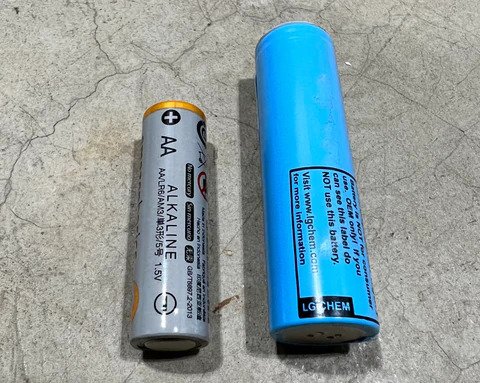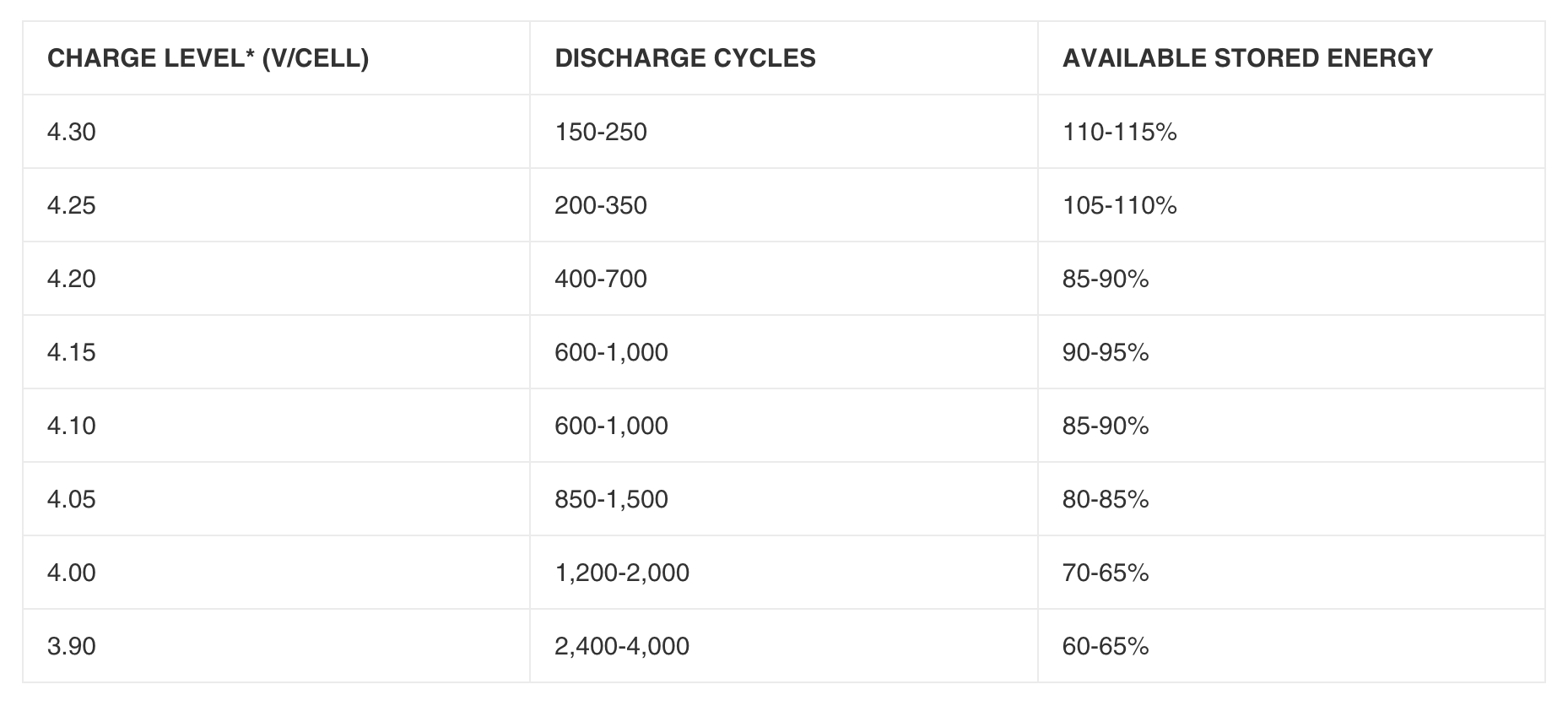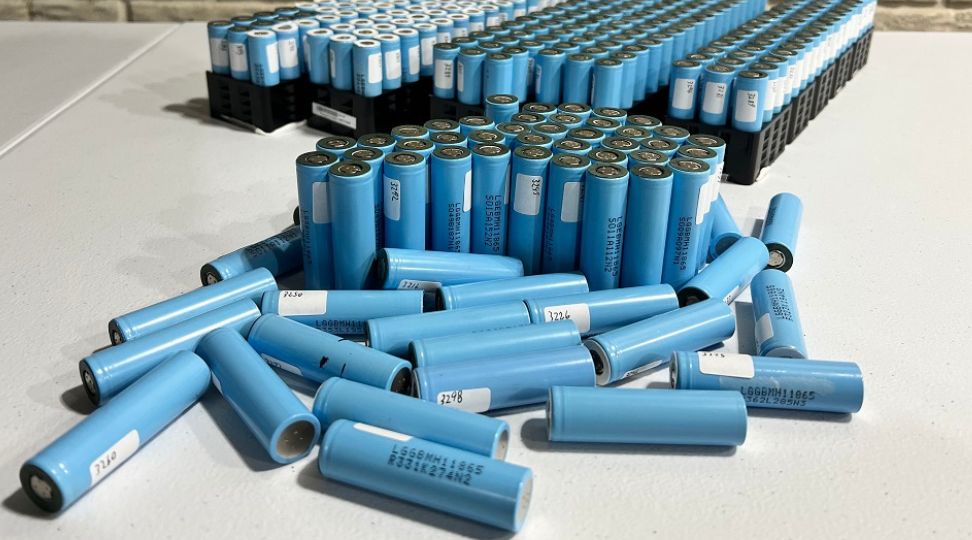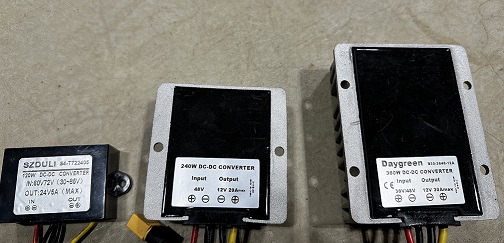
How To Get More Cycles Out Of Lithium Ion Cells
Table of Contents
- What Causes Lithium-ion Cells To Age?
- So, What Exactly Is A Lithium Cell Cycle?
- How Is Cycle Life Calculated?
- How Many Cycles Do You Get Out Of A Lithium Battery?
- It's Important To Optimize Temperature
- Can lowering Charge Voltage Extend Battery Life?
- Raise Cut-off Voltage to Increase 18650 Battery Lifespan
- Lowering Charge Current Increases Life
- Lowering Your Discharge Current
- Do 18650 Cells Have A Memory?
- What Is The Shelf Life Of 18650 Batteries?
- Conclusion
To get more cycles out of lithium-ion cells, it's crucial to manage the charging and discharging parameters carefully. One effective method is to lower the charge voltage to below the standard 4.2 volts per cell, ideally around 4 volts. This slight reduction in charge voltage can significantly increase the number of cycles the battery can endure, albeit with a minor reduction in capacity. Additionally, raising the cutoff voltage above the typical 2.5 to 3.0 volts per cell can also extend the battery's cycle life. By not fully discharging the cells, the stress on the battery is minimized, which in turn prolongs its lifespan.
Another important factor in extending the cycle life of lithium-ion cells is controlling the charge and discharge currents. Using a lower charge current reduces the stress on the cells during charging, which can help to maintain their health over more cycles. Similarly, designing the battery pack to ensure that each cell only provides a modest current during discharge is beneficial. This can be achieved by increasing the number of cells in parallel in the battery pack, which distributes the load more evenly among the cells. Additionally, maintaining optimal operating temperatures and avoiding extreme temperature conditions can prevent capacity loss and further enhance the cycle life of the batteries. By following these guidelines, it is possible to achieve several thousand cycles from lithium-ion cells, significantly improving their longevity and performance.
In this article, we will discuss tips and procedures that will ensure that you get the most cycles out of your lithium-ion battery packs.
What Causes Lithium-ion Cells To Age?
Lithium-ion battery cells work based on the movement of ions between the positive and negative electrodes. In an ideal battery, this mechanism would work perfectly forever. Unfortunately, however, the lithium-ion charging and discharging process causes a tiny amount of damage each time.
This manifests itself as the battery loses its ability to hold as much of a charge as it did when it was new.
A battery's State of Health is a function of its capacity, internal resistance, level of self-discharge, and other factors. As time and use passes these things worsen over time leading to the degradation of the cells. When it comes to 18650 battery cells, there are several important parameters to keep up with.
These parameters are especially important if you are working with salvaged cells. So, if you would like to learn more about these key aspects, then check out our article on how to properly salvage 18650 cells.
Capacity
Capacity, often rated in milliamp-hours (mAh), is a critical metric that determines how long a battery can sustain a constant discharge of electric energy at a given rate. Essentially, it indicates the total amount of charge a battery can hold. The actual mAh value of a cell is influenced by various factors including discharge current, temperature, and the cell's wear level. If you're interested, you can check out our other articles on how to test a battery's capacity.
For example, higher discharge currents can reduce the effective capacity because they generate more heat and increase internal resistance, which results in the loss of energy. Temperature also plays a significant role. Batteries typically perform best at moderate temperatures, as extreme heat or cold degrades capacity.
CDR (Continuous Discharge Rating)
Continuous Discharge Rating (CDR) is a measure of the maximum current a battery cell can deliver continuously without overheating or degrading prematurely. This figure is important for applications that require a steady, reliable output of power. While the CDR represents a sustainable current output, the peak discharge rating, which is often much higher, indicates the maximum current the cell can provide for a short burst. The length of this burst generally ranges between 10 and 30 seconds.
For example, a cell with a CDR of 5 amps might have a peak discharge rating of 20 amps or more. However, relying on peak discharge frequently can significantly shorten the cell's lifespan due to the stress imposed on its internal structure. The manufacturer's spec sheet will generally provide detailed information on how long a cell can sustain such higher currents without damage, which is essential for designing battery systems that need both high performance and longevity.
Charge Current
Charge current refers to the rate at which current is supplied to a battery cell during charging. Manufacturers typically specify three values for charge current: typical, minimum, and maximum. The typical value represents a standard charging rate that balances speed and safety, the minimum value is the lowest recommended rate to avoid any adverse effects, and the maximum value is the highest rate the cell can handle without risk of damage.
To get more cycles out of lithium ion cells, you should charge them at or below their typical charge current. Charging at lower currents reduces the stress on the cell’s internal components, which minimizes the heat that is generated and reduces the risk of thermal runaway. Also, slower charging rates can help maintain the cell's structural integrity and chemical balance, which are critical for long-term performance.
So, What Exactly Is A Lithium Cell Cycle?
Believe it or not, there is really no clearly defined understanding of what a complete cycle is. Generally, when an 18650 battery is fully charged, fully discharged, and then fully charged again, that is considered to be one cycle. The confusion comes from the fact that the charge voltage and cutoff voltages can be chosen by the user. So really, you choose what a cycle really is.
18650 lithium-ion battery cells have a maximum charge voltage of 4.2 volts. The low voltage cutoff, which is when a cell is considered to be totally depleted of usable energy, is somewhere between 2.5V and 2.8V. Lithium-ion cells also have a maximum discharge rating. The rating is usually only achievable for 10 to 30 seconds. If you ever go past this mark, it will accelerate the degradation of the cell.
How Is Cycle Life Calculated?
The SoH or (State of Health) is a percentage that represents your battery's overall health. While SoH is not based on capacity alone, you can get a pretty decent estimation of SoH by calculating the ratio of a cell's measured capacity compared to the ratings provided in the manufacturer's spec sheet.
For example, if your cell is supposed to be able to store 2200mAh, but now it is only able to store 2000mAh in it, that cell has a 91% SoH. Generally speaking, an 18650 battery cell is no longer good if it has an SoH of 80% or less.
Also, as lithium-ion cells age, their IR (Internal Resistance) increases. Brand new cells have an ISR of around 20 to 50 mOhms. As a cell is cycled more and more, its internal resistance will increase up to and beyond 100 mOhms. Once a cell reaches this level, it should no longer be used.
How Many Cycles Do You Get Out Of A Lithium Battery?
The average 18650 cell will have a cycle life of 300 - 500 cycles when used at its rated limits. It is important to note, however, that when a cell is exposed to high temperatures and high-drain situations, this can lower cycle life to around 200 cycles.
If you go over the maximum discharge current limit, it's even worse. This will decrease the cycle life down to as little as 40 or 50 cycles. In ideal conditions, 18650 cells can achieve much more than 500 cycles. In fact, if you do things right, you can get several thousand cycles out of your cells.
It's Important To Optimize Temperature
Cell temperatures are often overlooked. Always check your spec sheet, but a typical 18650 cell is rated to run best between 30 and 40 degrees C. So, when running a battery outside of those ranges, you will see an efficiency loss. In fact, for every 10-degree deviation, you will lose a significant amount of capacity.
When it comes to the cycle life, running 18650 cells too cold can be just as bad as running them too hot. And while standard lithium-ion chemistry is not as sensitive to low-temperature conditions as LFP variants, make sure to never charge 18650 cells when ambient temperatures are below freezing as this can reduce their overall cycle life.
Can lowering Charge Voltage Extend Battery Life?
Yes. You do not have to charge cells to 4.2 volts per cell. If you want the most cycles from your cells, then you should charge them at no more than 4 volts per cell. Charging to 4 volts per cell gives you a little less capacity, but a lot more cycles. In order to accommodate the new lower charge voltage you may want to build custom a lithium charger.
The only caveat to this is if you are never fully charging the battery pack, it may not clear the threshold for BMS balancing to begin. Most BMS will trigger balancing once groups of cells reach a certain voltage. If you never reach that voltage point the BMS will never work to balance the battery pack, over time this can cause your pack to go severely out of balance.
NOTE: The chart above is for *reference* only and was sourced here. You should *never* charge a lithium-ion cell over 4.2 volts.
Raise Cut-off Voltage to Increase 18650 Battery Lifespan
To achieve the longest run time, lithium-ion battery packs generally have a default cut-off voltage of 2.5 to 3.0 volts per cell.
If you want the most cycles out of your battery, you should increase the cut-off voltage to something higher than the LVC (Low Voltage Cutoff) stated in the spec sheet. This partial cycle setup will greatly reduce the stresses on your battery pack, and will, therefore, provide a much longer cycle life.
If the battery pack is optimally designed and the best charge and discharge methods are used, it's not uncommon for a 18650 cell to reach 1000 or even 2000 cycles.
Lowering Charge Current Increases Life
Not all chargers let you change the charge current. So, if possible, get a charger that has that feature. If you don’t want to have to adjust the settings, then you could always buy an undersized charger. For example, if your battery pack calls for a 4 amp charger, you could always get a 3 amp charger. We also put together a guide on how to build a bench power supply and charger, with this you will be able to fully customize your charging parameters.
The slower charger will be compatible with your battery, and it will stress your cells less. The ability to lower charge current is critical for extending the cycle life of your 18650 battery pack. We also did a write-up on the best 18650 chargers and testers, you can check that article out to find chargers that allow more flexibility.
Lowering Your Discharge Current
If you want to make your battery pack last as long as possible, it's important to take into consideration your load when designing your battery pack.
If possible, design your system so that an individual cell is exposed to no more than 0.2c of discharge current. This can be achieved by building your battery pack with as many cells in parallel as possible. This can also be done by throttling the load you put on the battery, for instance in an e-bike you can limit the controller's input current.
The amount of current each cell has to provide can be calculated like this:
Single Cell Amps = (Load Watts / Battery Volts)/Parallel Cells
For example, if you have a 7S4P battery that is a 500-watt load, that comes out to about 19.3 amps. Each cell will have to provide 4.8 amps of current. If you doubled your parallel cells by building a 7S8P battery, then each cell would only experience 2.4 amps of current while running the same 20 amp load.
NOTE: As battery voltage drops, it will require more current from the battery pack to sustain the same load current. So, when planning your build, it's always a good idea to plan around how many amps your battery will have to provide at the lowest voltage it can run at.
Do 18650 Cells Have A Memory?
No. Lithium-ion batteries don't have a memory effect. So, that means that the first charge does not have to be an 8 to 10-hour charge.
Also, because lithium cells have no memory effect, they can be charged and discharged at any time without affecting their capacity. This is in contrast to older battery technologies such as nickel cadmium, which needed to be fully charged and fully discharged to get the most capacity out of them.
What Is The Shelf Life Of 18650 Batteries?
18650 cells have a very long service life when properly stored. They can last up to 10 years on the shelf if kept at typical room temperatures and at their nominal voltage per the manufacturer's spec sheet. This will typically be 3.6-3.7 volts. However, even though there are very slight losses lithium batteries can go bad when not in use.

Conclusion
Battery packs don’t last forever. Due to the unfortunate lack of perfection in the underlying processes that make lithium-ion batteries work, they wear out over time. There are, however, some things you can do to get more cycle life out of 18650 cells.
Lowering the charge voltage and raising the cutoff voltage are the most effective ways that you can get the most out of your cells. If you want to take things a bit further, you can lower the charge and discharge current by using as many cells in parallel as possible, which will make your battery pack run cooler.
We hope this article helped you learn how to get the most cycle life out of your 18650 cells, thanks for reading!




